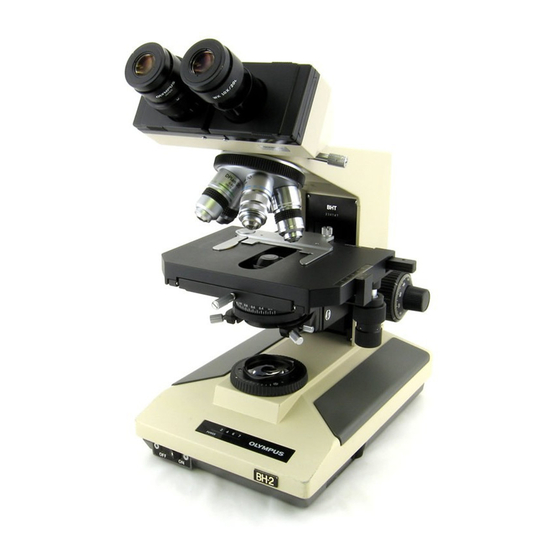Olympus BH-2 BHTU Pembongkaran, Pembersihan, dan Pemasangan Kembali Lengkap - Halaman 7
Jelajahi secara online atau unduh pdf Pembongkaran, Pembersihan, dan Pemasangan Kembali Lengkap untuk Mikroskop Olympus BH-2 BHTU. Olympus BH-2 BHTU 23 halaman. Sliding focus block
Juga untuk Olympus BH-2 BHTU: Manual (24 halaman)

process, and that any necessary personal protective
equipment is utilized to minimize exposure. Consult the
MSDS sheet before using any unfamiliar solvents. Many
of the solvents listed above are flammable and their
vapors may represent an explosion hazard if
mishandled. Whichever solvents are chosen, be sure to
follow all of the manufacturer's instructions and safety
precautions.
Solvent Compatibility with Parts and Finishes
Many solvents will damage the finish of painted
surfaces (isopropyl alcohol or 409 Cleaner may be safely
used to clean most painted surfaces) or will dissolve or
damage plastic parts. Do not allow untested solvents to
contact any plastic parts or any painted surfaces.
Before using a solvent to clean plastic parts or painted
surfaces, test a small amount of the solvent in an
inconspicuous area (such as inside a plastic knob) to
ensure compatibility with the plastic part or painted
surface. Never use xylene to clean nylon parts, as
xylene dissolves nylon. Isopropyl alcohol and
trichloroethylene will cause swelling of nylon due to
solvent absorption. The list of solvents generally
considered safe for nylon includes acetone, diethyl
ether, heptane, mineral spirits, naphthalene, and
turpentine.
Recommended Lubricants
The Olympus BH2 (BHS) repair manual (see the Original
Olympus
Documentation section of this document)
recommends using grease in the sliding focus block
mechanism. However, based on decades of experience
servicing BH‐2 equipment in the field, some microscope
repair technicians recommend omitting the grease
entirely from the sliding focus block, in order to reduce
the fouling of the mechanism which can occur if dust
and debris accumulates in the greased slides, as well as
reducing any stiffness or sluggishness that will result
from thickening of the grease. Given this conflicting
guidance, consider that grease may be applied to the
slide per the Olympus guidance, at the risk of requiring
more frequent maintenance to keep the mechanism
clean and freely moving, and grease may be omitted, at
the risk of more long‐term wear of the mechanical
components. Mobil Polyrex
(items 7 and 5 of
Appendix
lubrication is desired in the slide. Regardless of
whether or not lubrication is used in the slide, a heavy
grease such as Dow Molykote® 111 (item 6 of Appendix
2) should be used to hold the guide rails in place during
reassembly, and any excess grease remaining after the
guide rails have been installed should be thoroughly
Complete Teardown, Cleaning, and Reassembly of the Olympus BH‐2 Sliding Focus Block
TM
EM or Molykote® 44
2) are recommended if
removed before proceeding with the reassembly of the
sliding focus block mechanism.
Label Parts for Identification and Reassembly
There are many small parts that make up the sliding
focus block mechanism. It is critical that these be
bagged and tagged as they are removed to prevent
them from getting lost and to facilitate their proper
identification during reassembly.
Part of a Comprehensive Focus Overhaul
Maintenance of the sliding focus block is best
performed as part of a comprehensive overhaul of the
entire focus mechanism. It is best performed after a
teardown of the coaxial focus mechanism has been
performed, since this service is easier to perform while
the focus knobs and other focus parts are not present
on the arm. Accordingly, this document describes (and
the accompanying photographs show) the service being
performed on a stand that has had the coaxial focus
block completely disassembled, per the
Teardown, Cleaning, and Reassembly of the BH‐2
Coaxial Focus Mechanism
case where the sliding focus block is sluggish and needs
to be serviced, the coaxial focus mechanism is also in
need of a similar service, so it makes sense to perform
both repairs at the same time.
Protect the Exposed Mounting Dovetails
Before proceeding with the teardown described in this
document, cover the top of the microscope arm (i.e.,
the exposed mounting dovetails for the viewing head
and nosepiece, if applicable) with a clean plastic bag
and secure this with a rubber band or adhesive tape to
keep dust out (see
important on BHSU and BHTU stands which have an
optical correction lens located just below the viewing
head to correct for the difference in tube length
introduced with the reversed nosepiece.
Figure 2 – Protect the top of the arm from dust
Complete
document. In almost every
Figure
2). This is especially
Revision 2
Page 7 of 23
